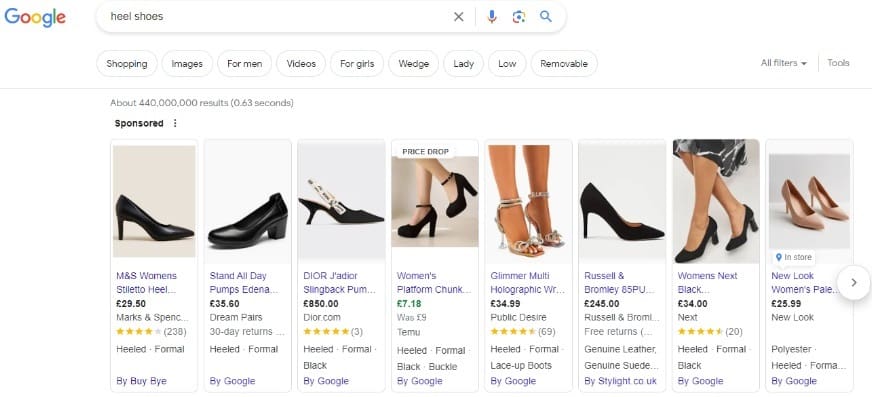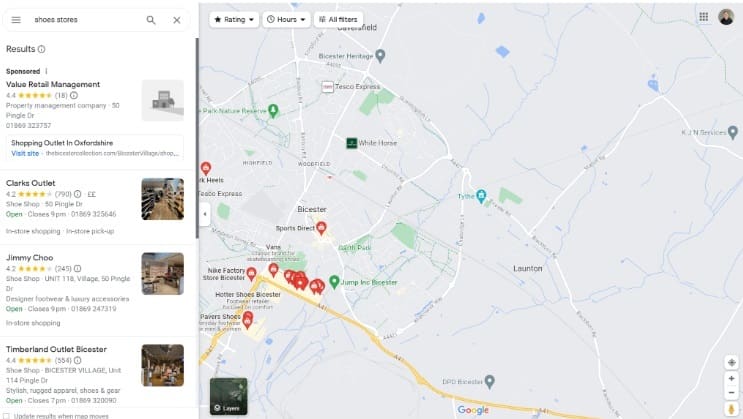Google Ads Campaign Types; What campaigns are available, what do they do, what are their benefits, and why should I use them?
These are some of the questions we’ll be answering in this concise, to-the-point guide.
Without wasting any time, let’s get right into it…
Search Campaigns

Who are they for? Search ads are a great choice for businesses looking to drive qualified traffic to their site, by targeting searches that are relevant to your offering.
What do they do? Search campaigns help you reach customers who are actively searching for your brand or products/services you’re offering with text ads amongst Google’s search results.
Where do they appear? Search ads will typically appear above/below organic search results on the Search Engine Results Page. However, they can also appear in search results on other websites across the web that are a part of the Google Search Network.
What are their benefits? Search campaigns have a variety of benefits. They can drive sales, leads, and boost traffic to your site by showing your ads to in-market searchers. Search campaigns can also increase awareness of your brand, by showing your ads on searches for competitor terms, as well as above organic search results at the top of the SERP.
What are their disadvantages? With search campaigns, you’re limited to a select number of characters to craft your ads with, which can make it challenging to capture attention in such a short space. In addition, Search campaigns require you to invest time to review performance and optimise your campaigns on a regular basis, making them quite time-consuming.
Display Campaigns

Who are they for? Display campaigns are a great way of building brand awareness and reaching new audiences across the web.
What do they do? Display campaigns allow you to run visual, eye-catching ads across the internet and deliver ads on over 2 million sites worldwide.
Where do they appear? Display campaigns are served on Google-owned properties, such as YouTube, as well as millions of websites and apps that are signed up to the Google AdSense program, where they must meet strict requirements in order to gain Google’s approval.
What are their benefits? Display campaigns are a great way to highlight your brand in a visual format. They’ll enable you to create memorable ads that increase brand awareness, reach internet users on sites that are popular with your target audience, and drive traffic to your site.
What are their disadvantages? Display ads are usually shown when users aren’t in-market and looking to buy instantly, hence the intent to purchase is much lower. This typically results in lower Click-through rates, as well as a lower conversion rate. However, Display can prove to be a profitable channel in the long run, as users will begin to recall your brand, and could then convert at a later date.
Performance Max Campaigns

Who are they for? If you’re short on time to manage your ads, but seeking maximum reach across all of Google’s channels, Performance Max may be the perfect campaign type for you.
What do they do? Performance Max campaigns allow you to serve ads across all of the channels in the Google Ads Inventory from one campaign, whilst utilising Google’s automation to automatically tailor performance for you.
Where do they appear? Your Performance Max ads will show across the entire Google network (such as YouTube, Gmail, Search), all from a single campaign.
What are their benefits? Performance Max campaigns are goal-focused, meaning that they’ll prioritise working towards and delivering results based on what matters most to you. They also leverage Google’s automation to automatically adjust keyword bids, decide when to best show ads, and more based on performance data.
What are their disadvantages? Although they may sound like the perfect campaign type, Performance Max campaigns do have a drawback… Insight. They offer very little insight into why campaigns are performing the way they are. This is due to Google stripping back the data available to the advertiser, and instead entrusting the machine to take the heavy work.
Shopping Campaigns

Who are they for? If you’re an eCommerce business looking to promote your inventory to a wider digital audience, Shopping ads are made for you.
What do they do? Shopping campaigns allow you to promote your store’s products on Google to an audience who’re actively searching for your offering. They make the purchasing process quicker and more efficient for the customer, by offering a ‘buy now’ call-to-action that leads directly to your item product page.
Where do they appear? Shopping ads appear on the search results page, as well as the Google Shopping tab.
What are their benefits? Shopping campaigns allow you to list your products using visually engaging product listings in a place where many users are in-market and ready to buy. Due to this, they can be a great way to bring in sales, as well as show your products at a time when a user may be looking for a similar competitor product.
What are their disadvantages? It can be harder to appear against competition with Google Shopping campaigns, especially if you have a lower budget. This is due to almost every major retailer utilising the space, hence the competition levels are often high. In addition, Shopping campaigns aren’t just a ‘set-and-forget’ campaign type. They require a large amount of regular optimisation to ensure they’re running to their full potential.
Video Campaigns

Who are they for? Similar to Display, Video campaigns are a great way of building brand awareness and reaching new audiences across the web. They can also enable you to reach users who are already aware of your brand, but are yet to convert.
What do they do? Video campaigns allow you to reach millions of users with engaging, visual ads across YouTube and the internet.
Where do they appear? Video ads are primarily shown on Google’s YouTube platform, which gives you the potential to reach up to 2 billion active users.
What are their benefits? Using video campaigns, you’ll be able to truly tell your brand’s story across a variety of ad types. They’ll also enable you to create memorable ads that increase brand awareness, reach internet users on channels that are popular with your target audience, and of course, drive traffic to your site.
What are their disadvantages? Although Video ads do not cost much to deliver to an online audience, they can be costly to record and create the assets in the first place, especially for smaller businesses. In addition, these videos need to capture the viewer’s attention in a matter of seconds, or you’ll risk your ad being skipped.
App Campaigns

Who are they for? If you’re looking to drive installs and sign-ups of your application, App campaigns are for you.
What do they do? App campaigns allow you to promote downloads of your IOS/Android application across Google’s various networks.
Where do they appear? App campaigns show ads across Search, Play, YouTube, Discover, and over 3 million sites and apps.
What are their benefits? App campaigns can help you raise awareness of your app and drive downloads, encourage existing users to take actions within your apps, and pre-register for apps that are yet to be launched. They also offer automated targeting, bidding, and ad creation for ease of management.
What are their disadvantages? If you don’t have an app that is accessible on the Apple App Store/Google Play Store, then you won’t be able to run App campaigns.
Local Campaigns

Who are they for? If you have a physical store, Local campaigns can help you increase footfall and drive in-store visits from customers who will find you online. If you provide a service, local campaigns can also help you attract clients in your local area.
What do they do? Local campaigns enable you to reach nearby customers and bring them to your physical premises.
Where do they appear? Local campaign ads appear across Google’s largest properties, such as the Google Search Network, Maps, and Google Display.
What are their benefits? Local campaigns can help you reach users at pivotal moments, such as when they’re planning a physical store visit. They allow you to appear above organic competitor listings, which can help assist brand awareness.
What are their disadvantages? Local campaigns may require initial maintenance to ensure they are running to their full potential. This includes optimising your landing page to include local keywords, reviewing locations where the ad has served and monitoring the performance, and adjusting your ad copy/creative to reference each target location.
Discovery Campaigns

What do they do? Discovery campaigns enable you to share highly visual, personalised ad experiences to users who are ready to engage with your brand – all within a single Google Ads campaign.
Where do they appear? Discovery campaigns enable you to feature your ads across Google’s native platforms, such as Gmail, YouTube, Discover, and more.
What are their benefits? Discovery campaigns allow you to show your ads at a time when users are engaged and ready to discover your offering, thanks to the nature of placements nestled within rich, valuable content (such as the YouTube home page). Discovery campaigns also lean heavily on Google’s A.I learning, which automatically shows your ads to the right audience at the right time.
What are their disadvantages? Due to their highly visual nature, Discovery ads require you to provide Google with a variety of image assets to be used within the ads. If you’re a small business lacking your first-hand images, you may not be able to maximise your performance using Discovery ads, especially if you chose to use stock imagery.
Our Thoughts
As discussed in this guide, there is a whole lot more to Google Ads beyond the standard Search campaigns.
With new campaigns being continuously rolled out, such as the new Performance Max campaigns, there will never be a shortage of campaign types for advertisers to test for their offerings.
We’d recommend looking into each campaign type individually in more depth before deciding which is for you, such as reading our ‘What are Performance Max Campaigns?’ article.









